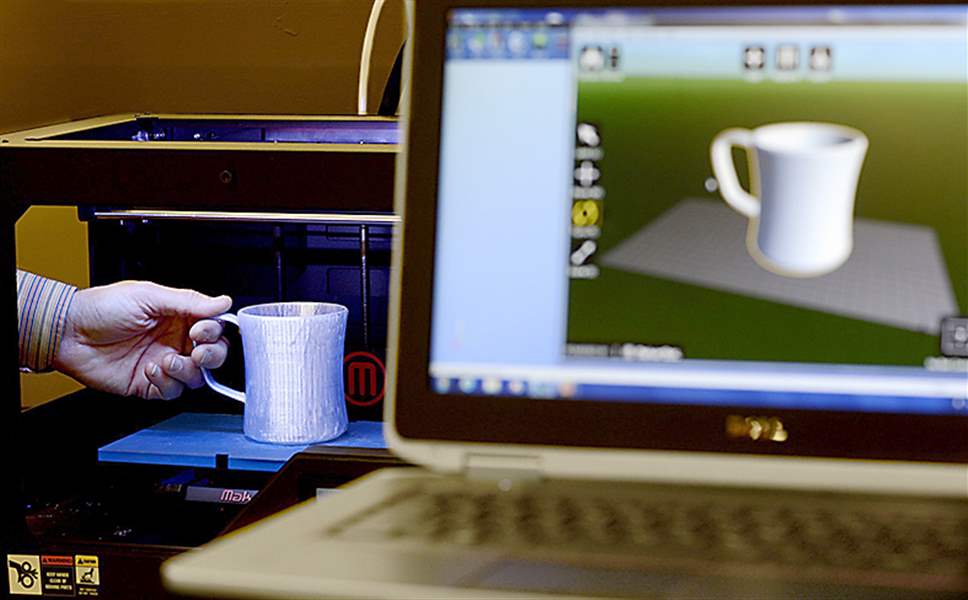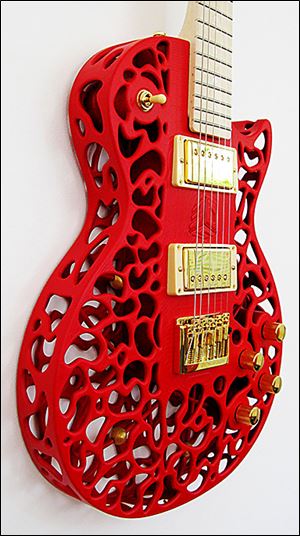
Even in its infancy, experts say 3-D printing technology will make sea change ‘in everything’
8/10/2013
It took 5 hours and 10 minutes to ‘print’ this coffee mug at the Prototype Studio at Hallmark in Kansas City, Mo. The technology that makes this possible is becoming omnipresent, and ideas that range from printable body parts and foods to musical instruments and houses are becoming realities.
KANSAS CITY (MO.) STAR

It took 5 hours and 10 minutes to ‘print’ this coffee mug at the Prototype Studio at Hallmark in Kansas City, Mo. The technology that makes this possible is becoming omnipresent, and ideas that range from printable body parts and foods to musical instruments and houses are becoming realities.
KANSAS CITY, Mo. — Tim Middleton lives and breathes now, but the mind of the 42-year-old Eudora, Kan., man often floats to the future, to what one might call the printable life.
It is a time — with tangible signs popping up with increasing frequency around the globe — when nearly any product one needs is created by simply pushing a button and printing it out in usable three dimensions.
A pair of glasses? Print it.
A knee joint? Print it.
“I have attempted printing my own shoes,” Mr. Middleton said, laughing.
He is a graphic designer who in the last two years has instructed more than 60 people on the art and science of 3-D printing in Saturday classes at Hammerspace, a community workshop in Kansas City, Mo., for builders, hobbyists, and inventors.
“They’re kind of hard,” Mr. Middleton said about his shoes. “The material is a little uncomfortable. But it is absolutely a possibility.”
More than possible: Such specialty 3-D-printed shoes exist, produced and sold along with 3-D-printed nylon bathing suits, jewelry, and dresses by Continuum Fashion of New York.
Cakes, cookies, sailboats, toys, architectural models, musical instruments, weapons, prosthetic hands and legs: All are items in recent years proved to be producible by 3-D printers.
Interest is high enough that the federal government last year earmarked $30 million to help support a new public-private institute in Youngstown dedicated to promoting and funding 3-D printing research.
It is a technology — although already considered overhyped in some circles — that many manufacturing experts say is even now only in its infancy, at a place similar to where personal and business computing was in the 1970s.
Like computing, they said, 3-D printing not only is likely to change the things we make and how we make and sell them, but also change how we live in good, bad, and inconceivable ways.
“It is a bit tricky to predict,” said Hod Lipson, who is a professor of mechanical engineering at Cornell University and co-author with Melba Kurman of Fabricated: The New World of 3D Printing, a 2013 book on the promises and perils of an emerging technology.

One of the 3-D printed guitar bodies made by Olaf Diegel.
“It is a little like trying to sit down in the 1970s and predict how computers were going to be used,” Ms. Kurman said. “Everyone could predict it would automate payrolls, but no one ever predicted social media.”
Given that caveat, Mr. Lipson predicted of 3-D printing: “It is going to change everything.”
Exactly when, how, and how much, of course, is difficult to say.
A May article in The New England Journal of Medicine described how two doctors in Michigan used a 3-D printer to save an infant’s life by printing a custom tracheal splint to support the baby’s airway.
In the last year, meanwhile, one young man’s mission to use a 3-D printer to produce a workable handgun sparked immediate outcry from the public and concerned government officials who envision the technology being used to put caches of cheap and untraceable guns into the hands of criminals or terrorists.
Understanding 3-D printing and the future requires understanding how most products are made now.
The range is broad, from printing to stamping, casting to injection molding.
Many manufacturing processes involve tooling or machining parts — a subtractive process that produces a part by cutting or chipping or shaving away.
“You start with a block of material and subtract things until you get what you want,” said Robert Landers, a professor of mechanical engineering at Missouri University of Science and Technology.
But the first word in 3-D printing’s alternative name, additive manufacturing, tells how it is different.
Instead of chipping or cutting away at some material, a 3-D printer’s nozzle runs back and forth, over and over again, oozing out layer after layer of whatever material is inside. It could be spools of plastic, metal, ceramic, or even cookie dough. These printers have been used to create a heart valve. Some predict the printers will use biological tissue to produce entire replacement organs.
Instructions for what to build are guided by software, much of which is free online. The 3-D printer builds a whole object in place, as if it were growing from the bottom up. Or it creates parts of an object that can be assembled.
Printers can be small enough to fit on a desk, using spools of thermoplastic filament that looks like weed trimmer line. Or they can be huge, with nozzles pouring out stonelike material to create walls or 10-foot-tall sculptures.
3-D printing technology is not new. It first came to public notice in the early 1980s, and industries and scientists began toying and experimenting with it soon after.
The airplane, automotive, and other industries have used industrial 3-D printers for years to design and test specialty parts.
What is new is the growth in the industry, particularly in personal 3-D printers produced by companies with names such as 3D Systems Corp., MakerBot, Stratasys, MakerGear, FlashForge, and Zen Toolworks.
In May, Staples Inc. became the first major U.S. retailer to announce it would soon be selling 3D Systems’ Cube 3-D printer at its stores, beginning in Europe, and also online starting at $1,299.